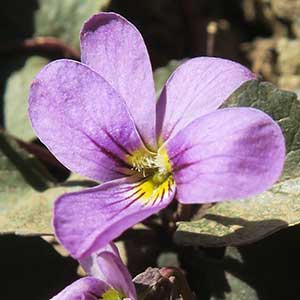Viola renifolia
Viola flettii
kidney-leaf or kidney-shape or white violet, kidney-leaf violet, kidney-leaf white violet, northern white violet, violette réniforme, white violet
Flett's violet, Olympic violet, rock violet
1–3, ascending to erect, mostly glabrous, on caudex from fleshy rhizome.
basal, 1–5, prostrate to ascending;
stipules linear-lanceolate, margins entire to sparsely laciniate, apex acute;
petiole 3–10 cm, strigose, sericeous, or villous, occasionally glabrous;
blade unlobed, reniform or ovate to broadly ovate or orbiculate, 1.5–3.5 × 2–5 cm, base cordate to broadly cordate, margins serrate-crenate, ciliate or eciliate, apex acute, obtuse, or rounded, occasionally acuminate, surfaces usually sparsely to densely strigose, sericeous, or villous throughout or along veins, sometimes glabrous.
basal and cauline;
basal: 1–3;
stipules linear-lanceolate, margins entire or with glandular processes, apex acuminate;
petiole 1.5–9.7 cm, mostly glabrous;
blade purple-tinted and –veined, broadly reniform to ovate, 0.9–2.4 × 1.2–4 cm, base cordate, margins finely crenate-serrate, eciliate, apex acute to obtuse, surfaces glabrous or sparsely pubescent along veins adaxially;
cauline similar to basal except: stipules ovate to lanceolate, margins entire or shallowly laciniate;
petiole 0.7–5.9 cm, usually glabrous;
blade 0.8–2.1 × 1.2–3.1 cm.
3–8 cm, puberulent.
1.8–7.1 cm, usually glabrous.
sepals lanceolate to ovate, margins usually eciliate, auricles 1–2 mm;
petals white on both surfaces, lower 3 purple-veined, all beardless or lower 3 sparsely bearded, lowest 8–10 mm, spur white, gibbous, 2–3 mm;
style head beardless; cleistogamous flowers on prostrate to ascending peduncles.
sepals lanceolate, margins eciliate, auricles 0.5–1.5 mm;
petals soft reddish violet on both surfaces, all with yellow area basally, lower 3 dark violet-veined, lateral 2 bearded, lowest with white around yellow area, 10–15 mm, spur yellow, gibbous, 0.5–2 mm;
style head bearded; cleistogamous flowers axillary.
ovoid to ellipsoid, 5–8 mm, glabrous.
± spherical, 5–9 mm, glabrous.
mottled beige to bronze, 1.5–2.2 mm.
dark brown to brownish purple, 2.5–3 mm.
= 24.
Viola renifolia
Viola flettii
Nonflowering plants of Viola renifolia and V. epipsila appear similar. The abaxial leaf surfaces of V. renifolia usually have a few short, straight hairs on the main veins; leaves of V. epipsila are usually glabrous (C. Parker, pers. comm.). Viola renifolia can appear similar to V. macloskeyi. V. B. Baird (1942) wrote that V. renifolia sometimes produces ascending stems. H. A. Gleason and A. Cronquist (1991) noted that if stolons were present, they were short and racemelike with cleistogamous flowers. The ascending stems and stolons mentioned by these authors may or may not be different phases of the same structure.
(Discussion copyrighted by Flora of North America; reprinted with permission.)
Viola flettii is endemic to the Olympic Mountains of northwestern Washington. C. S. McCreary (2005) noted that although morphologically and ecologically distinct, V. cuneata, V. flettii, and V. ocellata are closely related.
(Discussion copyrighted by Flora of North America; reprinted with permission.)


